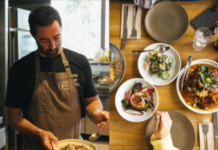By Vishnu Makhijani
New Delhi– At first glance, it looked like an oversized brown puff bloated at the centre. Then, Executive Chef Simran Singh Thapar gently sliced away at the edges and lifted the lid to reveal a gently steaming spring chicken, the aroma taking one back to its origin, Kot Kapura in Punjab.
“The chicken is marinated with freshly-ground Punjabi garam masala, enclosed in a whole wheat crust and slow cooked for two-and-a-half hours at 140 degrees (C) in a combi oven to ensure proper circulation of heat,” Thapar, who has curated the Kiyan’s Unsung Recipes of India food fest at south Delhi’s The Roseate, told IANS with a justified gleam in his eye.
The effort was completely worth it. The lightly-flavoured chicken easily came off the bone and didn’t need more than three quick bites to float down the throat. The Atta Chicken, as the dish was called, provided an unusual and rather pleasant start to the meal.
“People like to experiment so we had to go beyond the ordinary. We did extensive research in Punjab, Rajasthan and other parts of the country, even going down south to dig out recipes that had either gone into oblivion or were little known outside their limited regions and bring them alive again,” Thapar said as a Moscow Mule cocktail was served up.
Like the chicken, the vodka-based drink was gentle on the tongue with its combination of lemon juice and ginger beer and garnished with ginger juliennes and a lemon slice.
How then did the festival come about?
“It’s not just about preparing good food. Each dish has a story to be revealed that gives not just the chef but also the servers a chance to connect with our guests and provide not only food and service but an experience they’ll remember for a long time,” F&B Manager Manas Tiwari explained.
Such has been the response that the festival, which began on August 17 and was originally intended to run till August 30, has now been extended by a month.
It was then time for Thapar, who had begun his career in the Merchant Navy but realised his calling lay elsewhere, to serve a Meen Polichathu. He gently unwrapped a banana leaf to reveal a generous portion of sole marinated with coastal tamarind and spices.
“We discovered this in the Kochi region (of Kerala),” Thapar, a 11-year veteran in the field, said.
It was one of the few occasions I had touched fish and didn’t regret it one bit as the flavours exploded in the mouth and it too quickly slid down the throat.
As we headed up north again, it was time for a change in cocktail, this time a Liberator, with the vodka this time accompanied by pineapple juice, chunks of the fruit, coriander leaves and crushed ice.
One could almost feel the cold of Himachal as a Sepu Badi was served up — home-style lentil dumplings simmered in a spinach and yoghurt gravy and inspired by the Himachali “Dham” and served with a tawa roti. The “Dham” in fact traces its roots to the Kashmiri Wazwan but without the meat. This did not really matter as the ingredients blended perfectly, aided no doubt by the Liberator.
The Paya Shorba that followed was served rather uniquely: Into a large soup bowl went the ingredients — lamb trotters and assorted vegetables — over which the stock was poured. It certainly helped to retain the crunchiness because, otherwise, even in the few minutes that it would have taken to transport this from the kitchen to the table, this aspect would have been lost.
Next up was a strong competitor to the opening dish, this one a Railway Mutton Curry served with a Malabar parota.
“It is said that this was the handiwork of some pantry boys on a Madras-Bangalore train during the colonial era. The manager of the pantry car thought it was fit to be served in First Class but this could not happen till Independence,” Thapar explained.
The parota — this one made out of maida — blended seamlessly with the braised mutton curry and its potatoes and coconut milk, disappearing quite quickly. Let’s just call it a tie between the chicken and the mutton.
There was hardly any space left in the stomach for the final offering, but such was the aroma of the Hyderabadi Mash Ki Daal — urad daal topped with crunchy red onions and baby lotus stem — that one couldn’t resist soldiering on. For all its simplicity, it packed quite a punch, reinforcing the view that the essence always lies in simplicity.
And finally, there was the Kulfa, yes, Kulfa, an Amritsar speciality, topped up with falooda.
Overall, it made for loads of nostalgia that lingered for long after I had left the hotel. (IANS)












